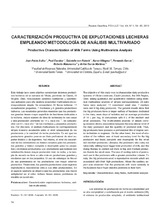Caracterización productiva de explotaciones lecheras empleando metodología de análisis multivariado
Productive Characterization of Milk Farms Using Multivariate Analysis
Autor
Avilez, Juan Pablo
Escobar, Paul
von Fabeck, Gabrielle
Villagran, Karen
García, Fernando
Matamoros, Roberto
García Martínez, Antón Rafael
Editor
Facultad de Ciencias Veterinarias, Universidad de ZulíaFecha
2010Materia
Explotaciones lecherasAnálisis multivariado
Multivariate analysis
Dairy farm
METS:
Mostrar el registro METSPREMIS:
Mostrar el registro PREMISMetadatos
Mostrar el registro completo del ítemResumen
Este trabajo tuvo como objetivo caracterizar sistemas productivos
lecheros de la comuna de Vilcún, provincia de Cautín, IX
Región, Chile, relacionando variables cualitativas y cuantitativas
aplicando para ello análisis estadístico multivariado de correspondencia
simple. Se encuestaron 24 fincas lecheras: 11
consideradas pequeñas, 7 medianas y 6 grandes productores
lecheros. Los resultados generales muestran que los productores
grandes tienen mayor superficie de hectáreas dedicadas a
la lechería, mayor número de días de lactancias de sus vacas
y una producción promedio de 14 L vaca día –1, en comparación
con 9 L vaca día –1 de los medianos y pequeños productores.
Por otro lado, el análisis multivariado de correspondencia
simple muestra asociación entre el nivel educacional de los
productores y la cantidad de leche producida. Es así que los
productores grandes poseen un título profesional de nivel superior
técnico o de ingeniero. Así mismo, el nivel de escolaridad
de los ordeñadores es básico completo para los productores
grandes y básico completo e incompleto para los pequeños
y medianos productores. Los productores que realizan dos
ordeños/día tienen mayor producción total de leche, y la terapia
de secado se lleva a cabo más en productores grandes y
medianos que en los pequeños. El uso de estanque de frío es
de uso permanente en los productores con mayor volumen
productivo. Finalmente, los grandes productores usan registros
reproductivos asociándose esto a sus altas producciones. En
el aspecto sanitario se observa que los productores con mayor
antigüedad en el rubro lechero tienen menos problemas de
mastitis en su rebaño. The objective of this study was to characterize dairy productive
systems of Vilcún commune, Cautín province, the IXth Region,
Chile, linking qualitative and quantitative variables using statistical
multivariate analysis of simple correspondence. 24 dairy
farms were analyzed: 11 considered small size, 7 medium
ones and 6 big dairy producers. The general results show that
the big producers have a larger surface of hectares dedicated
to the dairy, more days of lactation and an average production
of 14 L per day, in comparison with 9 L of the medium and
small producers. The multivariable analysis of simple correspondence
shows association between the educational level of
the dairy producers and the quantity of produced milk. Thus,
big producers have possess a professional title of degree senior
technician or engineer. On the other hand, the level of education
of the milkers was at least secondary level for the big
producers and basic complete and incomplete for the small
and medium producers. Likewise, the producers who carry out
twice-daily milking have bigger total production of milk, and the
drying therapy is carried out more in big and medium producers
than in the small ones. The use of cooling tank is of permanent
use in the producers with a greater productive volume. Finally,
the big producers used a reproductive records which are
associated with their high productions. About the sanitary aspect
was observed that the producers with more seniority in
the business have fewer mastitis problems in their herd

